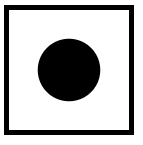I’d really welcome experience and advice from others on how to accurately place round holes for surface eyelets on facings.
Patterning
I’ve got comfortable marking the centers of holes very accurately on pattern pieces:
- Pattern the leading edge of the facing.
- Mark a seam line inward from the edge.
- Mark a margin line for empty space inward from the edge seam line.
- Mark a center guideline inward from there by the radius of the eyelets.
- Set a compass to the desired space from eyelet center to eyelet center, then walk it up the center guideline from tab to topline, starting one radius’s distance from the margin line at the tab. For boots, sometimes I’ll adjust the spacing and mark again to ensure the last eyelet ends where I want it. Other times I’ll move the topline up or down so the space from top eyelet to top edge is the same as from the leading edge of the tab to the first eyelet.
From there, I can transfer the center holes to leather with awl pricks or pen marks.
Punching
The trouble starts when trying to accurately punch holes perfectly centered on those holes. I’ve tried a few methods:
-
Eyeball the placement of the punch and press it just hard enough to leave a faint impression on the surface. Check centering by eye and readjust until I give in and punch the hole.
Sometimes I miss a couple times and have to press the leather with my finger to erase the lines from the previous attempts.
-
Use a drafting circle template to scribe a circle a millimeter wider in diameter than the hole I want to punch on the leather. Then set the punch so its edge falls just within the scribed line, all the way around.
The plastic templates I have from Helix and Staedtler all have crosshair-like markings of the center at four spots along the circumference. But it can still be hard to know when the template is perfectly centered on the hole.
-
Use the circle template, but mark and punch the holes out of the patterns, then trace those holes onto the leather.
I still don’t feel like I’ve really got this figured out for high accuracy and precision.
I have found that I can get more accurate results using drive punches on the bench than using punches screwed into my Italian twist press. That way I can use my fingers to help position the punch more like a pen. I can also just get my face closer to whatever I’m punching over.
Existing Tools
Hollow/Wad/Self-Centering Punches
There appears to be a somewhat niche tool for punching holes around marked center points: a “wad punch”, sometimes called a “hollow punch” or “self-centering punch”. These seem to be used mainly for punching round gaskets out of rubber and other sheet materials.
Osborne makes a set with 1⁄4, 5⁄16, and 3⁄8″ punches, plus wider ones.
Maun in Britain make a similar Imperial kit, as well as a metric version with 5, 6, 8, and 10 mm punches on the smaller end.
There are also China-made clones, sometimes marked both metric and imperial, as if they were exactly equivalent.
These kits do have punches down to eyelet-esque sizes. But they’ve clearly heavy tools meant for punching relatively large holes through heavy material.
Some shoe and leather stores carry the Osborne kit in particular. It’s expensive, as are the Maun kits on import. The Chinese clones aren’t too bad, but that feels like a lot for what it is.
Bow Compass
The purpose-designed drafting tool for drawing small circles around center points is apparently called a “bow compass”, sometimes “drop bow compass”. Wikipedia has a very nice photo:
I’m not sure these are actively manufactured anymore. There are listings for used ones online, but they’re older, mostly Rotring or Koh-i-Noor.
These are very appealing tools, but hardly seem worth the price. They also wouldn’t cut or punch the holes, just mark them.
Tool Ideas
I have a few ideas that I haven’t tested yet:
-
Glue lines of thread across the crosshairs of one of my cicle templates. Where they cross will be the centers. The threads will stop from tracing the circles all in one go, but tracing four rays, around the threads, should be enough to give the same guiding effect.
-
Pick up a cheap set of transfer punches, which are tools used to slide through holes and mark their centers on the other side. Use the size that fits the inner diameter of the eyelet I want to use the closest, set its center on the center point, then run the eyelet down the shaft of the punch and press it into the leather or pattern paper.
https://www.harborfreight.com/28-piece-transfer-punch-set-3577.html
-
Punch out some discs in the diameters I want in something like nylon, mark their centers, drill small holes through them, then check them and keep the most accurate.
-
Get some stamps made of circles in various diameters, with their center points.
